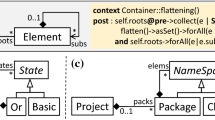Abstract
Meta-models play a pivotal role in Model-Driven Engineering, as they are used to define the structure of instance models one level below. However, in some scenarios, organizing meta-models and their instances in multi-level models spanning more than two levels yields simpler solutions. This fact has triggered the proposal of different multi-level modelling tools and approaches, although each one of them supports small variations of the multi-level concepts.
In order to benefit from multi-level technology, existing meta-models and their instances could be migrated manually, but this is error prone, costly, and requires expertise for choosing the most appropriate tool and approach. Hence, we propose an automated migration process. This way, starting from a meta-model annotated with multi-level “smells”, our approach creates a neutral multi-level representation, and recommends the most appropriate tool according to the required multi-level features. We present an initial prototype, and a preliminary evaluation on the basis of meta-models developed by third parties.
Similar content being viewed by others
References
Atkinson, C., Gerbig, R., Fritzsche, M.: A multi-level approach to modeling language extension in the enterprise systems domain. Inf. Syst. 54, 289–307 (2015)
Atkinson, C., Kennel, B., Goß, B.: The level-agnostic modeling language. In: Malloy, B., Staab, S., Brand, M. (eds.) SLE 2010. LNCS, vol. 6563, pp. 266–275. Springer, Heidelberg (2011). doi:10.1007/978-3-642-19440-5_16
Atkinson, C., Kühne, T.: Reducing accidental complexity in domain models. SoSyM 7(3), 345–359 (2008)
Clark, T., Sammut, P., Willans, J.S.: Super-languages: developing languages and applications with XMF, 2nd edn., CoRR, abs/1506.03363 (2015)
de Lara, J., Guerra, E.: Deep meta-modelling with MetaDepth. In: Vitek, J. (ed.) TOOLS 2010. LNCS, vol. 6141, pp. 1–20. Springer, Heidelberg (2010). doi:10.1007/978-3-642-13953-6_1
de Lara, J., Guerra, E., Sánchez Cuadrado, J.: When and how to use multi-level modelling. ACM Trans. Softw. Eng. Methodol. 24(2), 12 (2014)
Frank, U.: Multilevel modeling - toward a new paradigm of conceptual modeling and information systems design. Bus. Inf. Syst. Eng. 6(6), 319–337 (2014)
Gerbig, R., Atkinson, C., de Lara, J., Guerra, E.: A feature-based comparison of melanee and metadepth. In: Proceedings of MULTI@MODELS. CEUR, vol. 1722, pp. 25–34 (2016)
Igamberdiev, M., Grossmann, G., Selway, M., Stumptner, M.: An integrated multi-level modeling approach for industrial-scale data interoperability. SoSyM 1–26 (2016, to appear)
Jahn, M., Roth, B., Jablonski, S.: Remodeling to powertype pattern. In: Proceedings of PATTERNS, pp. 59–65 (2013)
Jeusfeld, M.A., Neumayr, B.: DeepTelos: multi-level modeling with most general instances. In: Comyn-Wattiau, I., Tanaka, K., Song, I.-Y., Yamamoto, S., Saeki, M. (eds.) ER 2016. LNCS, vol. 9974, pp. 198–211. Springer, Cham (2016). doi:10.1007/978-3-319-46397-1_15
Lamo, Y., Wang, X., Mantz, F., Bech, Ø., Sandven, A., Rutle, A.: DPF workbench: a multi-level language workbench for MDE. Proc. Est. Acad. Sci. 62(1), 3–15 (2013)
Macías, F., Rutle, A., Stolz, V.: MultEcore: combining the best of fixed-level and multilevel metamodelling. In: MULTI@MODELS. CEUR, vol. 1722, pp. 66–75 (2016)
Mouelhi, T., Fleurey, F., Baudry, B.: A generic metamodel for security policies mutation. In: Proceedings of ICST, pp. 278–286. IEEE Computer Society (2008)
Neumayr, B., Schuetz, C.G., Jeusfeld, M.A., Schrefl, M.: Dual deep modeling: multi-level modeling with dual potencies and its formalization in F-Logic. SoSyM 1–36 (2016, to appear)
Selway, M., Stumptner, M., Mayer, W., Jordan, A., Grossmann, G., Schrefl, M.: A conceptual framework for large-scale ecosystem interoperability and industrial product lifecycles. Data Knowl. Eng. 1–27 (2017, in press)
Acknowledgements
Work supported by the Spanish MINECO (TIN2014-52129-R) and the R&D programme of the Madrid Region (S2013/ICE-3006).
Author information
Authors and Affiliations
Corresponding author
Editor information
Editors and Affiliations
Rights and permissions
Copyright information
© 2017 Springer International Publishing AG
About this paper
Cite this paper
Macías, F., Guerra, E., de Lara, J. (2017). Towards Rearchitecting Meta-Models into Multi-level Models. In: Mayr, H., Guizzardi, G., Ma, H., Pastor, O. (eds) Conceptual Modeling. ER 2017. Lecture Notes in Computer Science(), vol 10650. Springer, Cham. https://doi.org/10.1007/978-3-319-69904-2_5
Download citation
DOI: https://doi.org/10.1007/978-3-319-69904-2_5
Published:
Publisher Name: Springer, Cham
Print ISBN: 978-3-319-69903-5
Online ISBN: 978-3-319-69904-2
eBook Packages: Computer ScienceComputer Science (R0)




